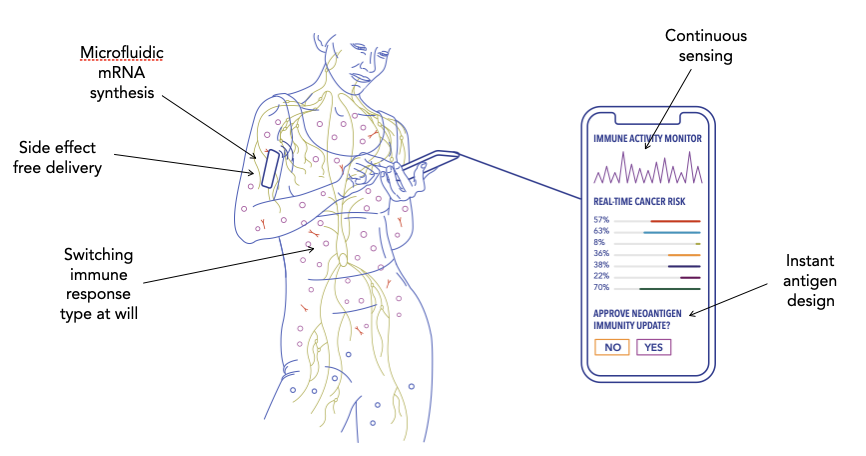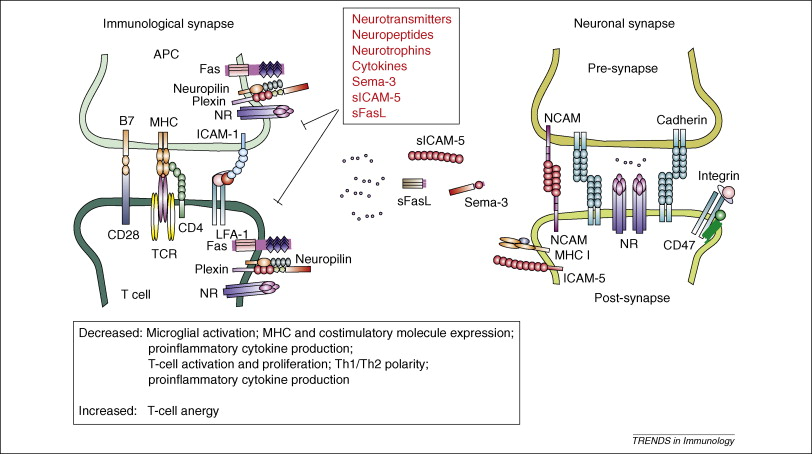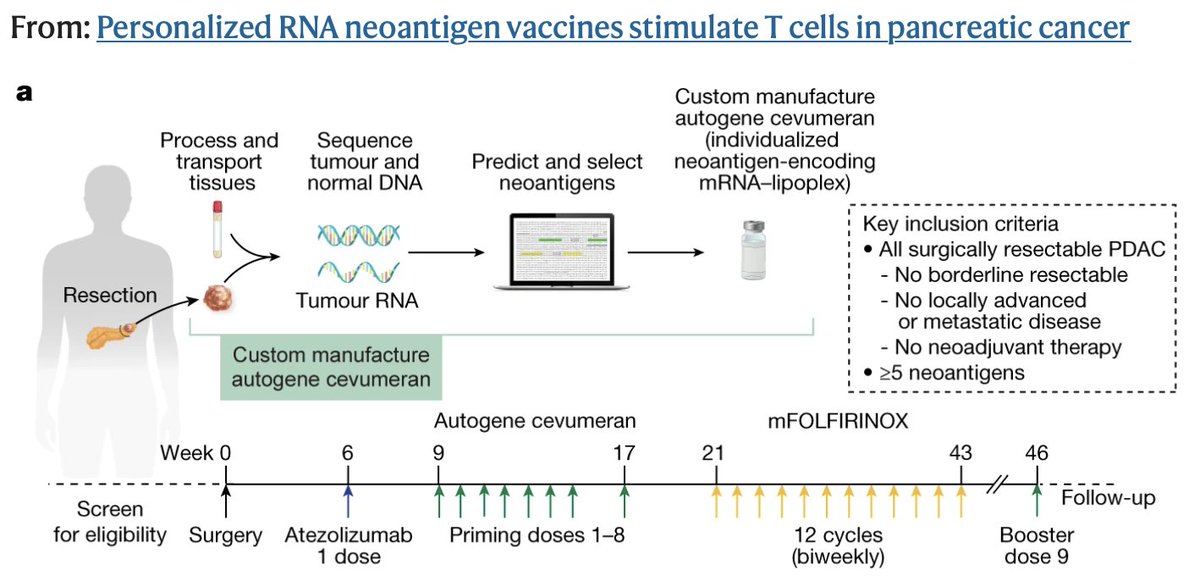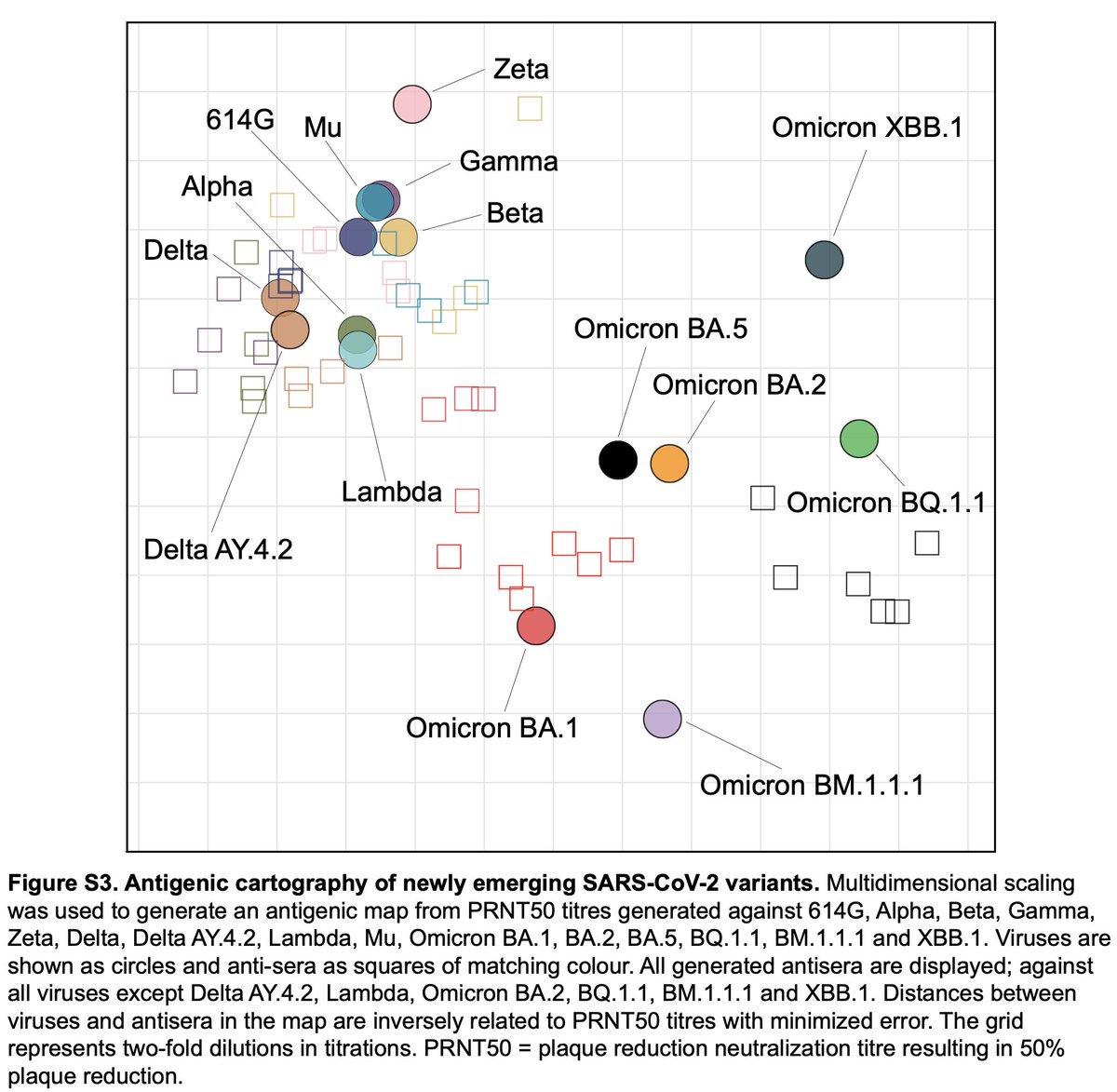Our immune system is amazing, but faces pandemics, cancer and aging. It's also wired to reject what we need to extend our healthspans & minds: organs, implants, new genes. It's time to radically augment it. We need to build an immune-computer interface (ICI). A manifesto🧵! 

We have two systems that adapt to our environments and maintain our identity: brain and immune system. One is 1.5kg of neurons and other cells inside our skulls; the other is 1.2kg distributed immune cells. Both process signals, learn and remember. Both define self and non-self.
So far, we've put a lot of effort into augmenting our brains. Language, writing, and now computers have vastly amplified our natural intelligence, and deeply rewired our brains and culture. Can we do the same for the immune system? What would that even mean? Why do we need to?
The whys are obvious. The immune system is powerful, able to recognize 10^15 targets, but can struggle against novel pathogens (pandemics). Aging makes it weaker. It can mistake friends for enemies (organ transplants), or enemies for friends (cancer). It needs help!
But why an immune-*computer* interface? What do computers have to do with the immune system? Well, immune failures are mostly failures of information processing. A two-way coupling to an external computational medium is the obvious route to remedy them.
Like the brain, the immune system processes data. Its inputs are biological molecules (potential threats) the body is exposed to, both internal and external. The outputs are molecular or cellular responses to them. (Figure: Daëron, 2022) 

The similarities are not superficial! Immune activation involves a junction between cells that pick up and display potential threats (APCs) and immune cells - an immunological synapse. Like neuronal synapse, it integrates and transmits signals.(Figure: Gahmberg et al, 2009.) 

Immunological and neuronal synapses share aspects of molecular architecture, components, and an evolutionary lineage all the way back to basic environmental sensing by cells ().elifesciences.org/articles/66706
This suggests that we might proceed by analogy with brain augmentation. Computers are intelligence amplifiers. Can they be immune amplifiers? To see how, let's revisit bicycle of the mind pioneers, J. C. R. Licklider, and Douglas Engelbart, whose work he funded via ARPA.




In his classic 1960 paper, Man-Computer Symbiosis (), Licklider argues that a computer system for problem exploration through trial and error not only enables faster solutions, it actually expands the space of problems that can be formulated. groups.csail.mit.edu/medg/people/ps…


A key part is making this process interactive and real-time -- something almost unthinkable at the time of writing. 

Engelbart made this more concrete in "Augmenting Human Intellect: A Conceptual Framework in 1962. (). He outlines a virtuous cycle of computers enhancing human thinking via better symbol manipulation, making it easier to improve the computer, and so on. dougengelbart.org/pubs/papers/sc…


These ideas underlie all software we use today. In 1968 Mother of All Demos (), stage managed by @stewartbrand, Engelbart and team demoed windowed operating system, the mouse, collaborative editing ... So they can be made very concrete.
We can repurpose the Licklider / Engelbart key ideas for immune augmentation:
1. Two-way coupling to a computer via matching processes that can be improved in a virtuous cycle with the immune system.
2. Real-time feedback loops between the immune system and the computer.
1. Two-way coupling to a computer via matching processes that can be improved in a virtuous cycle with the immune system.
2. Real-time feedback loops between the immune system and the computer.
The technologies to build an immune-computer interface based on these principles are almost in place - with some gaps we'll get to. Let's break them down, starting with how we transmit information to the immune system. Currently, we do this with vaccines.
Vaccines are a rudimentary one-way immune interface. They train immune system with a harmless version of what we want it to respond to. Simple, yet saves more lives than any other medicine. I love this description of vaccines as molecular loving-kindness. econ.st/3PI6vHo


Basically, a vaccine shows immune cells a biological molecule with a danger signal attached. Classic vax use weakened (MMR) or inactivated viruses (polio) or bacterial toxins. Recombinant DNA led to subunit vaccines, where just the key pathogen part is made in cell culture.
A subunit vaccine is an information processing shortcut! In natural infection, immune system searches through possible responses (antibodies that stick to different parts of virus, T-cells that recognize virus parts in infected cells) until virus replication stops.
But we can often experimentally figure out what the immune system should hit. For example, several years of coronavirus research allowed us to identify the spike protein on SARS-CoV-2 as the key target to block, and tweak it to make it more immunogenic than the natural one.
Thus, most COVID vaccines only deliver the (tweaked) spike protein. They tell immune cells to focus on it. This shortcuts the target search during infection. Effectively, immune system has outsourced the computational process of figuring out what to hit to us!
(As an aside, even the full spike protein is unnecessary; some COVID vaccines, including @HelixNano 's, only deliver the tip of the spike, the receptor-binding domain or RBD, which is targeted by the vast majority of so-called neutralizing antibodies that block infection.)
For an alternative and more entertaining explanation, I recommend this @xkcd comic that breaks it down with a Death Star. The subunit vaccine idea is that you just need to show the rebels the blueprints for the Death Star thermal exhaust port (RBD).m.xkcd.com/2425/
Obviously, this is far from a Lickliderian real-time process. It took years of research to pin down spike, and subunit vaccine development and manufacturing takes a long time. Regulatory hurdles aside, making protein antigens is a pain - each one needs a custom process.
This is why mRNA vaccines are so interesting: they deliver transient genetic code to instruct our own cells to make the active vaccine component (antigen/immunogen).
Crucially, all mRNA is manufactured the same way. To change mRNA payload, one simply changes the input DNA (which we can essentially print!), without changing the rest of the manufacturing process. It's an analog to digital like paradigm shift, still underrated.
This universality is also behind excitement around mRNA cancer vaccines, with some promising clinical results in melanoma and even in pancreatic cancer (). These vaccines - used as therapies, not to prevent - are custom made for each individual patient.nature.com/articles/s4158…
The process starts with a tumor resection/biopsy. Normal + cancer cell DNA are sequenced to spot unique mutations, which are then run through a neural network based algorithm to predict which are potentially visible to immune cells. The top ones are turned into a mRNA vaccine. 

There are big caveats here: this mainly works for removable, non-metastatic tumors; you have to freeze tumor evolution by cutting out tumor mass, or it's too easy for the tumor to evolve away from the mutations targeted. The neoantigen prediction algorithms don't work that well.
Still, in this particular $BNTX trial with 16 patients (also treated with an immunotherapy drug Tecentriq), 50% responded and had longer recurrence-free survival. Pancreatic cancer is one of the most aggressive cancers known, so any improvement to standard of care counts.
But what's really interesting here is that if you squint, this starts to look a bit like an immune-computer interface! 

You extract and read tumor genetic material in a way immune system can't. You computationally distinguish between self and non-self cells, the task immune system failed with cancer. You model a part of immune system itself (MHC presentation) to predict what it can hit ➡️ mRNA it.
It's still just one iteration loop - but it happens within weeks, not years, and is a true two-way street, where a computational pipeline and immune system work together against cancer, with tumor DNA and mRNA as communication layers. And it's a *process*, not a single drug!
So far, the limitations of the neoantigen approach and the clinical timeline have restricted this approach to a single loop, but if mRNA cancer vaccines can be made more potent, we could keep iterating, helping the immune system out-evolve cancer with multiple adaptive vaccines.
Conceptually, this is not so different from what is already happening with COVID boosters or flu vaccines, updated with viral evolution; only faster and taking place in a single patient.
Similar ideas are in the air. For example, @ARPA_H 's ADAPT program () is working towards tracking tumor changes and clinical trial designs to enable truly personalized care.arpa-h.gov/research-and-f…
But the idea of an immune-computer interface goes beyond specific applications and modalities. I admit I'm vaccine-pilled: there is something elegant about just giving immune system information and letting it figure out what to do. Still, biotech offers other tools.
For example, many blockbuster drugs are monoclonal antibodies (mAbs), synthetic versions of the pathogen-fighting molecules produced by B-cells. mAbs are also used e.g. in autoimmune disease and cancer. They interact with the native immune system and can be used to manipulate it.
Oncology is where immunotherapies have moved the needle the most. Like the mRNA neoantigen vaccine example shows, that's where the immune equivalent of jet fighters - complex stacked technologies - are being built.
Examples include cytokines (signaling molecules to make tumors immunologically "hotter"), checkpoint inhibitors (remove immune system's brakes), CAR-Ts (genetically engineered T-cells), TILs (T-cells extracted from tumors, expanded+reinfused), CAR-NKs/macrophages, and more.
Another emerging capability is turning off undesirable immune responses that drive autoimmune disease like MS or transplant rejection. This is less mature. Approaches range from tolerogenic "inverse vaccines" to CAR-T based depletion of B-cells producing autoantibodies.
Strikingly, *all of the above* immunomodulation strategies have already been or could be mRNAified, i.e. delivered in mRNA form ( for flavor). Especially when it comes to immune system, mRNA is all we need!jbiomedsci.biomedcentral.com/articles/10.11…
This is why it's now possible to talk about building a universal immune-computer interface. In mRNA, we have Engelbart equivalent of a computer-controlled display that can present any signal to the immune system. What about the other way? Can we map immune system in real time?
Almost. In recent years, DNA sequencing has advanced to the point where we can profile millions of immune cells and map their receptors & states. Large scale efforts like @waynekoff1 's @ImmunomePro are underway to map their diversity.
Mind-blowingly, we can even map physical interactions of immune cells in a living organism (). What is still missing is figuring out what antigen an immune cell binds to given its DNA sequence, but that's also coming fast - and a great AI problem.nature.com/articles/s4158…
The form factors are also shrinking. This is @nanopore 's MinION, a USB drive sized DNA sequencer. Its actual use requires other equipment and reagents, but it's still remarkable that it has been used to characterize immune responses to MMR vaccination (). nanoporetech.com/sites/default/…


Incidentally, mRNA manufacturing is being integrated and miniaturized too. Jacklenec et al () describe a standalone device able to print mRNA vaccines in a microneedle patch format.nature.com/articles/s4158…
Given all this, it's not unreasonable to imagine an actual ICI *wearable*, integrating both miniaturized mRNA manufacturing and single cell sequencing. Technologically this is <two decades away. It may not even be necessary for most applications, but is a useful end state image! 

(As an aside, I recently wrote a whole novel about a future where practically everyone has a system like this, with specific circumstances that force us to make immune systems digitally updateable. To be clear, in this thread, I'm discussing how we might *actually* build ICI. 😉)
There are two challenges to ICIs beyond technological: 1) In what settings can we build working ICIs that help patients, respecting regulatory realities? 2) What design abstractions can drive virtuous ICI cycles? What does immunology as design discipline look like?
Not coincidentally, these mirror the original Licklider/Engelbart principles we set out to apply in the immune context: feedback loops and iterative capability improvements.
First, mRNA vaccines enable iteration in animal models (for infectious diseases, oncology and others) at a much faster timescale than has been previously possible, ~3 weeks per experiment.
At @HelixNano, we have found this already lets us form mental models of biology that would be hard at the 10x slower pace of protein biologics, just like in Licklider's programming example. Integrated ICIs may thus have value simply as an immunotherapy development tool.
However, we really want human applications! We already discussed the possibility of adaptive, iterative vaccination in metastatic cancers. But that's still only serving a relatively small patient population, although one with a critical unmet need. Can we go bigger?
How about cancer *prevention*? 50% of us get cancer. It's becoming possible to detect it increasingly early. In liquid biopsies, cancer biomarkers are detected in a blood sample. The most common version (e.g. @GrailBio) involves sequencing circulating cancer DNA.
Liquid biopsies are still noisy and expensive, but rapidly getting better. In many cases (pancreatic cancer), they can already detect cancer well before there is standard of care treatment - they are not very actionable.
But we can make them actionable with a simple ICI-like framework. Imagine a world where you take a liquid biopsy test once or twice a year, using a home fingerprick kit you can mail or have picked up by drone, or at CVS.
If there is a positive signal - a set of cancer-associated, upregulated antigens, say - you immediately get a mRNA vaccine designed to rev up your immune system against those targets. You can go get a shot, or receive a band-aid like microneedle patch in the mail to self-apply.
(It hasn't escaped me that you could start this with dogs, @loyalfordogs style, and I definitely want this for our vizsla, Neo...but humans are the species who can make the most of ICI capabilities, even if we ultimately offer them to all sentient creatures.)
How far away are we from a cancer-preventing ICI? Liquid biopsies need to improve in sensitivity - but DNA sequencing continues to improve on a super-Moore's Law like curve. 

A technical issue is generating strong immune responses against early targets in cancer that are not extensively mutated: these can be dampened by self-tolerance, a mechanism that prevents autoimmunity. But this is exactly the kind of problem that mRNA design freedom can solve.
To be conservative, let's say cancer prevention ICI like this takes 10 years and 1-2 billion USD, including a 100,000-patient pan-cancer prevention trial. That’s a low price to pay for a dramatic cut (50%? 80%+?) in cancer rates, not to mention a population scale ICI scaffold.
ICI infrastructure like this immediately has other uses. Pandemic surveillance and response, or running clinical trials for any immune intervention. Standardized mRNA and readouts will make FDA pathways easier, akin to CBER head Peter Marks's proposal for AAV gene therapies.
Once we have built an ICI base around cancer prevention, other applications will start to suggest themselves. We might get a "Vacc Store" of digital immunotherapies, and new markets for personal immune data.
User control over data is definitely a big question, especially given that rare, powerful antibodies/TCRs/complex immune profiles become digitally copyable from one human to all. An immune-computer interface immediately gives rise to an immune Internet.
How do we treat a user's immune system as a co-creator of a new mRNA drug? Is their name on the patent? Can (say) specific immune cell gene expression patterns be patented? Should they?
Security is an obvious issue. Do we dare to connect our biology to computers, even in the transient cancer prevention ICI fashion? I would posit that in a world where engineered pathogens become commonplace, the *lack* of a powerful ICI network is a much greater security hole.
In this sense, ICIs are very aligned with ideas around differential technology development, or @VitalikButerin 's d/acc framework. Or @karpathy 's e/ia, if we are looking for labels...
https://x.com/hannu/status/1753517574401519830?s=20
There are some core values embedded in the very idea of an ICI. We all have immune systems; immune augmentation should be universally available, even more so than smartphones. ICI also respects immune system's innate intelligence and seeks to amplify it, not replace it.
The ICI idea is very generative. It invites questions. For example, would we feel more connected to each other if our immune systems were literally Internet-connected? How this is represented to the user is, of course, a system design choice. The right one is far from obvious.
That leads to the biggest remaining question: what should immune computer interface design abstractions be like? @michael_nielsen has written eloquently about the importance of powerful design ideas that we discover latent in laws governing matter.
https://x.com/michael_nielsen/status/1530577256652738561?s=20
(Excerpted from , very worth reading in full.)futureofmatter.com/maps_of_matter…
Just like with our minds and computers, ICIs have the potential to kick off a new flywheel of design imagination. Vaccine design in currently refers to choice and engineering of antigens. But we need higher level concepts built upon profiling millions of cells in an individual.
This might involve visualizations of high-dimensional TCR/BCR/antigen binding maps, or a much more sophisticated version of the kind of antigenic cartography carried out with COVID variant responses to serum samples from vaccinated individuals (Geurtsvankessel et al., 2023). 

And then we need verbs for acting upon these maps of immunity, tools for translating our intention into mRNA language that the immune system understands. The dimensionality of these datasets is such that we truly might need an AI partner for this. What to call it? An exothymus?
Or perhaps it will be like @KarlSchroeder 's deodands, but for the immune system - a digital twin and a voice for our biological self that can speak for this remarkable fluid intellect everywhere inside us that fights a thousand silent battles for us daily.
One key thing that is different from Engelbart's human-artifact schema is that we are trying to couple not two, but three information processing systems: human cognition, computers and the immune system. The design challenge is to create matching processes to encompass them all. 

We have already talked about some of the obvious benefits ICIs will bring: instant biodefense, eliminating cancer and autoimmune disease. As suggested by @geochurch, we can add fighting aging (largely an immune problem) to the list.
If we are successful, the human-computer-immune system will develop new emergent capabilities that we can't yet envision. What I find exciting about them is the opportunity to bridge the gap between thought and matter, signal patterns and biological molecules, self and non-self.
As a simple example, companies like @neuralink are building brain-computer interfaces. Brain state *writing* is likely to require biological tech like optogenetics, insertion of nonhuman ion channels into neurons that can be activated with light or other signals.
The opsin proteins used are typically microbial and immunogenic (). A high bandwidth interface might involve many opsinsin parallel. A flexible ability to induce immune tolerance to opsins is a prerequisite of a two-way mind meld with computers.frontiersin.org/articles/10.33…
Such an interface might of course be a part of future ICI, upgrading the immunoception mechanism brain already has to monitor and model immune activity to an actual new sensory modality. What would it be like to have an immune sense with the same vividness as vision or smell?
(For more on immunoception, see .)nature.com/articles/s4142…
In the realm of immune-brain coupling, there is mounting evidence that certain *beneficial* autoimmune responses in the brain are essential for neuroplasticity. Immunodeficient mice display impaired learning that can be rescued with T-cell infusions ().ncbi.nlm.nih.gov/pmc/articles/P…
If these connections pan out, an ICI could be a powerful neuroplasticity modulator, inducing brain immune responses coupled and adapted to what the user is trying to achieve, or perhaps even synchronized with the type of material they are trying to learn.
(ICI therapeutic implications for Alzheimer's, dementia, PTSD and brain injury are left as an exercise for the reader. Michal Schwartz's work on neuroimmunity in these conditions and beyond provides many starting points: )weizmann.ac.il/brain-sciences…
Of course, the opsin argument applies to anything new we might want to incorporate into our biology that the immune system now rejects. Tolerizing for organ transplants or xenotransplants is several steps up in complexity, but possible. Same goes for microbiome transplants.
Want to live on Mars? We need Deinococcus radiourans enzymes to protect our genomes from radiation - and have to convince our immune system to accept them. Want to go to the stars, freeze-dried? We need to tolerize for tardigrade CAHS proteins ()onlinelibrary.wiley.com/doi/10.1002/pr…
The point is that long term, an ICI lets us redraw the map of our biological self at will and give ourselves capabilities drawn from Earth's entire metagenome - a full exabase, 10^18 nucleotides of genetic material, compared to our own paltry 3 gigabases of DNA.
And that's not even counting the astronomically vast synthetic proteome AI protein models are now able to design -- all of which have to contend with immune rejection.
To put it another way, ICIs will let us form symbiotic interfaces with any living cell, incorporate new mitochondria-like organelles or entire new organs -- crucially, *without* germline genetic engineering, but by reshaping living humans.
But immune-computer interfaces have the power to transform how we live even before we go to the stars.
Recently, @SamoBurja pointed out to me that a society is defined by its drugs. A society where an ICI becomes the way we treat disease is very different from our present one.
It's a society where we co-create health for everyone with the powerful immune intelligence inside us.
It's a society where the already extant connections between our bodies are made manifest and amplified.
It's a society where the boundaries of our selves, biological and mental, become more fluid.
It's a society I think we should build.
I'll close with a plea inspired by the one Engelbart ended his 1962 paper with.
This is an open plea to researchers and to those who ultimately motivate, finance or direct them, to turn serious attention to the problem of augmenting our immune system in a total sense.
We have directed great resources at enhancing human intellect with computers. Now, let's do it for the immune system, and the human system as a whole. Let's give our descendants the power to redraw the map of what they can become.
If you made it all the way here: thank you for reading! Special thanks to @FawazAM and @michael_nielsen for encouraging me to write this, Nikolai Eroshenko for ongoing mind-meld, @HelixNano team for feedback and @AdamMarblestone and @dbgoodman for helpful comments. Onwards! 🙏🏻
And if you enjoyed this braindump, please retweet with molecular loving-kindness.
https://x.com/hannu/status/1774696537626640527?s=20
• • •
Missing some Tweet in this thread? You can try to
force a refresh




